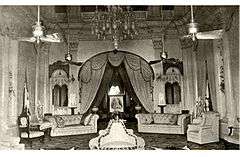Wasif Manzil
Coordinates: 24°10′58″N 88°16′10″E / 24.182663°N 88.269492°E
| Wasif Manzil | |
|---|---|
 An old photo of the palace's drawing room with Nawab Wasif Ali Mirza Khan picture at the back. | |
| Alternative names | New Palace |
| General information | |
| Location | West Bengal |
| Town or city | Murshidabad |
| Country | India |
| Completed | Present building was completed in 1904 after the earthquake. |
| Renovated | Renovations were done after the 1897 earthquake. Currently maintenance is done by the Archaeological Survey of India. |
| Destroyed | 1897 earthquake |
| Technical details | |
| Floor count | Present Building is a ground floor building with a terrace. The former building was a two storied palace. |
| Design and construction | |
| Architect | Mr. Vivian, officer of the Public Works Department of the Nadia Rivers Division and Surendra Barat, a Bengali engineer. |
| Website | |
| "Website URL". | |
Wasif Manzil (also known as Wasef Manzil and New Palace) was built by Nawab Wasif Ali Mirza Khan under the direction and supervision of Mr. Vivian, officer of the Public Works Department of the Nadia Rivers Division and Surendra Barat, a Bengali engineer. This building, rather palace was used by the Nawab as his residence. The building is extremely close to the Hazarduari Palace. It is built on the Nizamat Fort Campus between the campus's Dakshin Darwaza (south gate) and the Hazarduari Palace, just opposite the campus's South Zurud Mosque and parallel to the Bhāgirathi-Hooghly River.
Destruction

The palace was extensively destroyed in the 1897 earthquake on 12 June. The whole of the palace's second storey came down within a few seconds. It was repaired later but without the second storey. Adjacent to the palace was an artificial hill and a landscape garden which now cease to exist.
Features
The palace has been designed to look a little like a castle with small corner turrets on the corners. The palace has a semi-circular pediment with the Nawabs of Murshidabad's coat of arms on it. Now, the palace is maintained by the Archaeological Survey of India and has been transformed into a museum. The palace has a garden space in front of it which has a fountain and several marble statues. The garden space is enclosed with a handsome iron railing. The main entrance is a Norman archway with open-work iron doors. The staircases and statues inside the palace are also made of marble and are worth seeing.
See also
- Nizamat Fort Campus and other buildings built in the campus:
- Nawab Wasif Ali Mirza Khan, the Nawab who built this majestic palace.